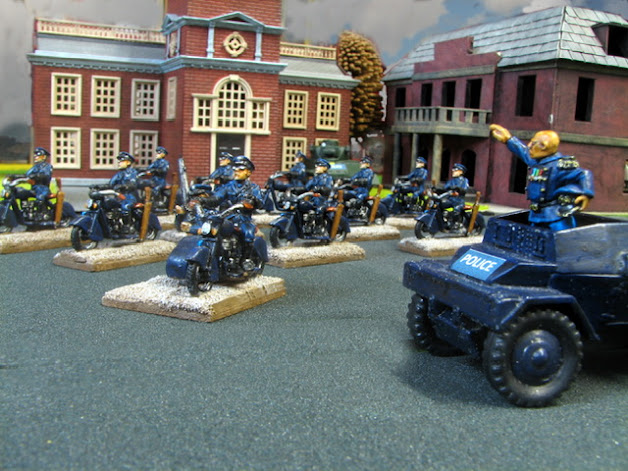Hereford was slow (some would say pleasingly and/or entirely characteristically) to take advantage of the great cinema going boom of the 1920s and 1930s. It was only in 1936 that the Alhambra, the old fashioned Victorian music hall in Gwynne Street, was demolished; at that point, films then appear to have been shown in the former Corn Exchange - converted into the Kemble Theatre - in Broad Street. Nevertheless, in 1937/1938, Hereford witnessed the construction of not just one, but two, purpose built cinemas - the Odeon in Commercial Street and the Ritz in Commercial Road:
 |
(1). The Odeon, 7 Commercial Street, opened in April 1937. This photograph also dates from
April 1937, the month of release for "Good Morning Boys" starring Will Hay. |
 |
(2). A photograph of the Odeon from 1949. Will Hay has long departed (in fact,
he died in April 1949, and the earliest this photograph could have been taken
is July, when "Sorrowful Jones" was released). |
 |
| (3). The splendid Art Deco interior of the Odeon. |
 |
| (4). Interior of the Odeon - a view from the right hand side of the dress circle. |
The casual tourist (or eager VBCW researcher) visiting Hereford today will search in vain for "The Odeon" and its fine Art Deco interior - unfortunately, it has now to be numbered amongst the "architectural losses" of the cityscape.
Unlike a number of other buildings, however, there is no suspicion that this loss was caused by "enemy action" during the course of the VBCW; the demolition of the Odeon in 1984 to make way for the (actually quite sympathetic) Maylord Shopping Centre redevelopment is too well-documented.
A quite different fate awaited the second (and even larger) purpose built Hereford Cinema, the red-brick Ritz:
.jpg) |
| (5). The Ritz Cinema, 100 Commercial Road, opened on 10th January 1938. |
 |
(6). A splendid extended view of the Ritz in the 1930s. A full sized cafe and tea room nearest the
camera. The cinema itself, reflecting the changing concerns and pre-occupations of the generations, was situated on the demolished remains of the Victorian County Gaol, itself built on the ruins of the
ancient Priory of St. Guthlac. |
 |
| (7). Interior of the Ritz, complete with the essential organist (Mr Frank Slater). March 1939 photo. |
 |
(8). A somewhat fuzzy (but best available) late 1930s view of the Ritz interior, organ in the centre.
Again Art Deco in inspiration, but not quite as exuberant as the interior of the Odeon. |
The Ritz remains with us today, but had a somewhat
chequered history of takeovers, buy-outs, and partial conversion (the stylish 1930s Cafe became the local Unemployment Benefit Office for a number of years, and part of the cinema was converted - shame to relate - into
a bingo hall). Final closure as a cinema took place in 2014, when an entirely new (multi-screen!) cinema was built in the course of the redevelopment of Hereford's old Cattle Market.
 |
(9). A wet Commercial Road in May 2000; pretty much the same shot of the Ritz Cinema as Photo (6) above. There has been a very noticeable increase in traffic over the intervening 70 years, the once
stylish Cafe now advertises itself as "Snack Bar and Amusements", and someone has thought to plant
a tree in order entirely to ruin the Art Deco vista. Sic transit.... |
 |
(10). The 2010s - the once "Snack Bar & Amusements" space converted into an "all you can eat"
Chinese restaurant, trading as "Planet". |
 |
(11). The Odeon in 2008. Having previously been divided into a cinema and bingo hall,
the bingo hall has now given way to a nightclub called "Dusk". |
 |
(12). It's 2014 - the end. The Odeon has moved to the redeveloped Old Market.
The nightclub stumbles on, rebranded from "Dusk" to "Fusion".
The now leafless tree remains. |
 |
| Post 2014, Christ and Mammon co-habitation. The cinema is now in use as a "Freedom Church", while "Fusion" continues its nightclub activities. The tree has not perked up. |
Thankfully, however, as we live in the VBCW of 1938, we do not need to consider the future of demolition and change of use: it is sufficient to celebrate the arrival of two wonderful new cinemas in the centre of Hereford (just in time for the outbreak of the civil war, of course) and the journeys of imagination that Herefordians will soon be entranced by:
 |
A long way from Hereford. Future blogposts will catalogue the types of films seen by Herefordians
during the course of the Very British Civil War....... |
Notes:
(A). The Alhambra Music Hall, situated in Gwynne Street and demolished in 1936:
 |
| Alhambra demolition 1936. |
(B). A local internet wag has cleverly pointed out the similarity between the Ritz Cinema, Hereford, and:
 |
| ....the Red Banner Textile Factory, Leningrad. |
 |
| The modern day Textile Factory has, nevertheless, rather more severe "tree issues". |
















.jpg)


































